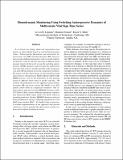| dc.contributor.author | Lehman, Li-wei H. | |
| dc.contributor.author | Nemati, Shamim | |
| dc.contributor.author | Mark, Roger G. | |
| dc.date.accessioned | 2016-06-06T17:18:03Z | |
| dc.date.available | 2016-06-06T17:18:03Z | |
| dc.date.issued | 2015-09 | |
| dc.identifier.isbn | 978-1-5090-0685-4 | |
| dc.identifier.isbn | 978-1-5090-0684-7 | |
| dc.identifier.issn | 2325-8861 | |
| dc.identifier.other | INSPEC Accession Number: 15800674 | |
| dc.identifier.uri | http://hdl.handle.net/1721.1/102995 | |
| dc.description.abstract | In a critical care setting, shock and resuscitation end-points are often defined based on arterial blood pressure values. Patient-specific fluctuations and interactions between heart rate (HR) and blood pressure (BP), however, may provide additional prognostic value to stratify individual patients' risks for adverse outcomes at different blood pressure targets. In this work, we use the switching autoregressive (SVAR) dynamics inferred from the multivariate vital sign time series to stratify mortality risks of intensive care units (ICUs) patients receiving vasopressor treatment. We model vital sign observations as generated from latent states from an autoregressive Hidden Markov Model (AR-HMM) process, and use the proportion of time patients stayed in different latent states to predict outcome. We evaluate the performance of our approach using minute-by-minute HR and mean arterial BP (MAP) of an ICU patient cohort while on vasopressor treatment. Our results indicate that the bivariate HR/MAP dynamics (AUC 0.74 [0.64, 0.84]) contain additional prognostic information beyond the MAP values (AUC 0.53 [0.42, 0.63]) in mortality prediction. Further, HR/MAP dynamics achieved better performance among a subgroup of patients in a low MAP range (median MAP <; 65 mmHg) while on pressors. A realtime implementation of our approach may provide clinicians a tool to quantify the effectiveness of interventions and to inform treatment decisions. | en_US |
| dc.description.sponsorship | National Institutes of Health (U.S.) (NIH grant RO 1-EBO 17205) | en_US |
| dc.description.sponsorship | National Institutes of Health (U.S.) (NIH grant RO I-GM 1 04987) | en_US |
| dc.language.iso | en_US | |
| dc.publisher | Institute of Electrical and Electronics Engineers (IEEE) | en_US |
| dc.relation.isversionof | http://dx.doi.org/10.1109/CIC.2015.7411098 | en_US |
| dc.rights | Creative Commons Attribution-Noncommercial-Share Alike | en_US |
| dc.rights.uri | http://creativecommons.org/licenses/by-nc-sa/4.0/ | en_US |
| dc.source | MIT web domain | en_US |
| dc.title | Hemodynamic monitoring using switching autoregressive dynamics of multivariate vital sign time series | en_US |
| dc.type | Article | en_US |
| dc.identifier.citation | Lehman, Li-wei H., Shamim Nemati, and Roger G. Mark. "Hemodynamic monitoring using switching autoregressive dynamics of multivariate vital sign time series." in 2015 Computing in Cardiology Conference (CinC), Nice, France, 6-9 Sept. 2015. IEEE, pp.1065-1068. | en_US |
| dc.contributor.department | Institute for Medical Engineering and Science | en_US |
| dc.contributor.department | Harvard University--MIT Division of Health Sciences and Technology | en_US |
| dc.contributor.mitauthor | Lehman, Li-wei H. | en_US |
| dc.contributor.mitauthor | Nemati, Shamim | en_US |
| dc.contributor.mitauthor | Mark, Roger G. | en_US |
| dc.relation.journal | 2015 Computing in Cardiology Conference (CinC) | en_US |
| dc.eprint.version | Author's final manuscript | en_US |
| dc.type.uri | http://purl.org/eprint/type/ConferencePaper | en_US |
| eprint.status | http://purl.org/eprint/status/NonPeerReviewed | en_US |
| dspace.orderedauthors | Lehman, Li-wei H.; Nemati, Shamim; Mark, Roger G. | en_US |
| dspace.embargo.terms | N | en_US |
| dc.identifier.orcid | https://orcid.org/0000-0002-6318-2978 | |
| mit.license | OPEN_ACCESS_POLICY | en_US |

